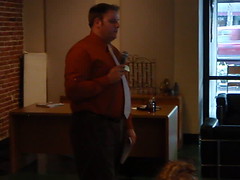 Corey Hull continued
his presentation on T-SPLOST at the Lowndes County
Democratic Party (LCDP) meeting by talking about
the statewide business plan for the state of Georgia.
It is not a project list; it’s estimates of how much money is needed
and how much money can be raised.
Corey Hull continued
his presentation on T-SPLOST at the Lowndes County
Democratic Party (LCDP) meeting by talking about
the statewide business plan for the state of Georgia.
It is not a project list; it’s estimates of how much money is needed
and how much money can be raised.
The plan identifies $35 billion to meet the needs in Georgia today. However, $72 billion are needed to meet the transportation needs to sustain Georgia’s economy into the future.Of course, that’s according to the Georgia Department of Transportation (GDOT), which notoriously is not interested in trains or other mass transit: if it’s not a road or a road bridge, forget it.
Continuing:
And $1 billion is needed here in Lowndes County. Lowndes County’s transportation plan through the Metropolitan Planning Organization has about a billion dollars in projects.A billion dollars right here in Lowndes County? Continue reading
